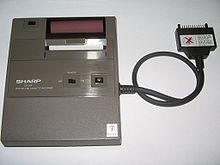
Back طباعة حرارية Arabic Impressió tèrmica Catalan Termotisk Czech Thermodruck German Θερμικός εκτυπωτής Greek Impresión térmica Spanish چاپ حرارتی Persian Printéir teirmeach Irish サーマルプリンター Japanese Термографиялық баспа құрылғысы Kazakh
| Part of a series on the |
| History of printing |
|---|
 |


Thermal printing (or direct thermal printing) is a digital printing process which produces a printed image by passing paper with a thermochromic coating, commonly known as thermal paper, over a print head consisting of tiny electrically heated elements. The coating turns black in the areas where it is heated, producing an image.[2]
Most thermal printers are monochrome (black and white) although some two-color designs exist. Grayscale is usually rasterized because it can only be adjusted by temperature control.[3]
Thermal-transfer printing is a different method, using plain paper with a heat-sensitive ribbon instead of heat-sensitive paper, but using similar print heads. Thermal transfer printer require the use of wax-based ribbons that adhere to the substrate during the printing process.[4][5] As a result, users must load both labels and ribbon, essentially using an alternative ink system.[6]
- ^ "Receipt Paper: Why It Fades and How to Restore It?". Panda Paper Roll. 2018-12-10.
- ^ "Definition of THERMAL PRINTER". www.merriam-webster.com.
- ^ "What is Grayscale Printing?". imagexpert.com. Retrieved 2025-01-29.
- ^ "Understanding Wax Ribbon: An Essential Guide". www.sunavin.com. Retrieved 2025-01-29.
- ^ "A Manufacturer's Guide to Using Thermal Printer Ribbons". www.elixirphil.com. Retrieved 2025-01-29.
- ^ "Direct Thermal Printer for Fast and Easy Label Printing". www.rollo.com. Retrieved 2025-01-29.